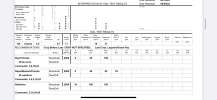Is that a big difference? Yes. No. Maybe. Maybe not. It depends on a lot of factors, soil characteristics, weather, and type of lime (screen size, etc) being major factors. The general rule(s)-of-thumb are guides only.
Couple of ideas have merit and others not so much. I can't tell the difference.
Is it better to work lime into the soil or leave it on top? There's much debate. Again, generally, mixing it in means into the top six inches of soil which, for talking purposes, weighs 2-million pounds. So a ton of lime into 2-million lbs? Second, mixing it in might improve soil pH to that depth, but where are the majority of the plant roots? Probably close to the surface.
My esteemed agronomy professor said (kinda like the Internet - if it's there it must be true) surface applied lime will move into the soil two or three inches every six months. As it moves deeper into the soil some of it vacates the upper surface inches. Point being, if you need a lot of pH boost - like requiring over 1 1/2 tons do a split application six-months apart, the theory being you have a consistent pH thru the "plow" layer.
Common knowledge says it takes a long time for lime to affect soil pH. What's likely happening? It takes the lime a long time to move into the soil...BUT here's the thing. On the soil surface after applying lime with no incorporation the pH begins to change immediately and can move into the 1-inch profile rather quickly slowing down as it goes deeper. So, for a new plant just germinating where are the roots? In the top 1 to 2 inches. Now your ton of lime is affecting not 2-million pounds of soil but only one-third or less of that amount. That's a HUGH boost to the situation!
Is it a big difference? Frankly, I prefer split applications of surface applied lime - if I need that much.


